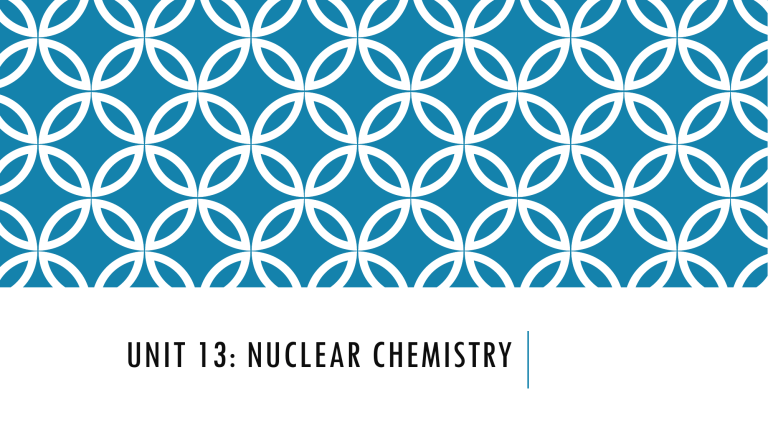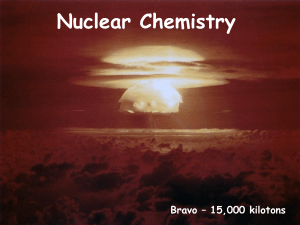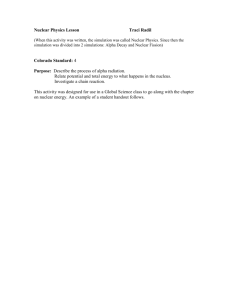
UNIT 13: NUCLEAR CHEMISTRY REVIEW: ISOTOPE NOTATION A An isotope notation is written as ZX, where X is the element, A is the mass number (sum of protons and neutrons), and Z is the atomic number. For example… 238 92U U is for uranium, mass number is 238, and atomic number is 92 The isotope can also be written as uranium-238 for short since uranium will always have the atomic number of 92. WHAT IS NUCLEAR CHEMISTRY? Nuclear chemistry is the study of processes in which the nuclei of various atoms change in some way. Three different types of changes: •Radioactive decay •Nuclear fission •Nuclear fusion RADIOACTIVE DECAY Radioactive decay is when an unstable nucleus breaks apart into smaller nuclei, or changes in some other way to make it more stable. All elements have radioactive isotopes in which the ratio of protons to neutrons makes the nuclei unstable. •All elements past uranium have NO stable isotopes. As a result, all of these elements undergo radioactive decay of some sort. NUCLEAR RADIATION When radioactive decay occurs, the nuclei of an element either gain or lose pieces in order to gain a more stable ratio of protons to neutrons. Here are the following types of nuclear decay you need to know: •Alpha radiation (α) •Beta radiation (β) •Gamma radiation (γ) ALPHA RADIATION •Alpha particle is a helium nucleus with 2 protons and 2 neutrons. It has a +2 charge. •Alpha particle can be written as 24α or 24He •Alpha particles are the largest type of radiation particle and most highly charged. •Alpha particles can be blocked by your hand, clothes, or a sheet of paper. ALPHA DECAY •This is when a nucleus loses an alpha particle (a helium nucleus) to become more stable. •One example of this reaction is the alpha decay of U-238 238 92U → 4 2He + 234 90Th EXAMPLE: polonium-210 thorium-230 BETA RADIATION •Beta particle is an electron. It has a -1 charge. •Beta particle can be written as 0 β or −1e. −1 0 •Beta particles are fast-moving and can have high energy. •Alpha particles can be blocked by thin metal foil. BETA DECAY •This is when there is an uneven ratio of neutrons to protons in the nucleus (too many neutrons), an excess neutron will split. •One example of this reaction is the beta decay of Lead-210 210 82Pb → 0 −1e + 210 83Bi EXAMPLE: carbon-14 thorium-231 GAMMA RADIATION •Gamma ray is high-energy photon or ray. It has a no charge. •Gamma ray can be written as 00γ •Gamma rays are high frequency and the most penetrating type of radiation. This makes them the most harmful to human. •Alpha particles can be blocked by thick lead shield or concrete block. GAMMA EMISSION •This is when the nucleus needs to get rid of excess energy and achieve stability during nuclear reaction. •Usually gets emitted along with alpha and beta particles. •One example of this reaction is the beta decay of Cobalt-60 60 27Co → 60 28Ni + −10e + 2 00γ Cobalt-60 decay by beta emission to excited Nickel-60. Then excited 60Ni falls to stable ground state of 60Ni by emission of 2 gamma rays EXAMPLE: carbon-11 oxygen-15 HOW TO WRITE A BALANCED NUCLEAR EQUATION •Step 1: Write the full symbol of the nuclide that’s decaying. •Step 2: One of the products of this reaction is the nuclear radiation particle (alpha, beta, or gamma). •Step 3: Figure out the other product. Because the law of conservation of mass does a pretty good job of describing how the world works, the mass of the particle and the atomic number will add up to be the same as the reactant side DECAY SUMMARY Type of Radioactive Particle Decay Emitted Change in Mass Change in Number Atomic Number Alpha Decay α Decreases by 4 Decreases by 2 Beta Decay β No Change Increases by 1 Gamma Decay γ No Change No Change BALANCED NUCLEAR EQUATION EXAMPLE Complete each of the following nuclear equation 1. 226 88Ra 2. 38 19K → 42He + ______________ → ____________ + −10β 3. ____________ + 10n → 15 1 N + 7 1H MORE EXAMPLE… Complete each of the following nuclear equation 1. 69 30Zn 2. 208 84Po → 69 31Ga → 233 3. 92U + ______________ 204 82Pb + 1 ______________ + 0n → 92 44Ru 1 + 3 0n + ______________ REMINDER!!! Quiz tomorrow…use the quiz review to help study Unit 13 test on Tuesday! NUCLEAR FISSION Nuclear fission occurs when large, unstable atoms (usually isotopes of uranium and plutonium) are split by a neutron into smaller, more stable atoms. During this process, huge amounts of energy are generated. HOW DOES NUCLEAR FISSION WORK? •Fission happens when the nuclei are bombarded by neutrons. •The large nuclei split into two or more smaller nuclei, releasing neutrons, and a large amount of energy. •A chain reaction can be created, and a tremendous amount of energy can be release in a very short amount of time. HOW DOES NUCLEAR FISSION WORK? NUCLEAR FISSION IN REAL LIFE Nuclear power plants are powered by fission reaction. Since a very large amount of energy can be released in a very short amount of time, fission must be controlled! A control rod is inserted into the reaction in order to absorb neutrons, and help keep the chain reaction from multiplying. NUCLEAR FUSION Nuclear fusion is the opposite of fission. Nuclear fusion occurs when smaller atoms fuse together to form larger, more stable atoms. This type of reaction releases even more energy than a fission bomb. NUCLEAR FUSION IN REAL LIFE •Fusion is hard to use in practical applications because it requires very high temperatures (108K). •Such extreme temperatures exist, however, in stars, and fusion is responsible for the energy released by the sun. WHERE DOES THE ENERGY COME FROM? The energy released from fission and fusion comes from the nuclear binding energy. Law of conservation of energy and law of conservation of mass… when the larger nuclei split up into smaller nuclei, some mass is loss. To make up for that loss, the energy is released. HALF-LIFE •Half-life: is the amount of time it takes for one-half of a radioisotope sample to decay into its products. •During one half-life, half of the original sample will decay. •The shorter the half-life time, the less stable the isotope is going to be. EXAMPLE: The half-life of the radioisotope strontium-90 is 29 years. If you had 10 grams of strontium-90 today, how much would you have 29 years from now? How much would be left in 58 years?


